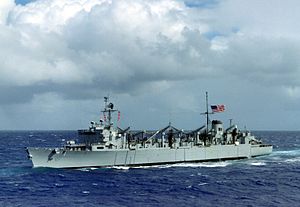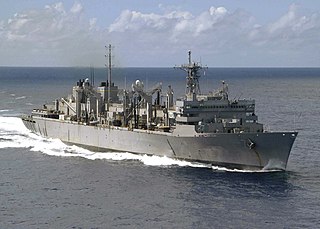
The fast combat support ship is a type of replenishment auxiliary ship. Different from traditional logistic ships, the fast combat support ship is designed with high speed to keep up with the carrier battle group/carrier strike group, while the multi-product station is capable of supplying all types of necessities for the fleet.
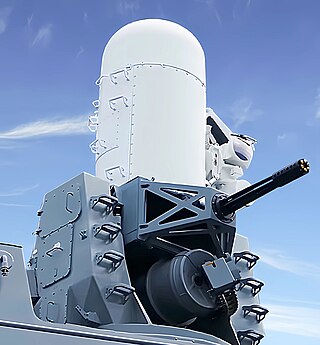
The Phalanx CIWS is a gun-based close-in weapon system to defend military watercraft automatically against incoming threats such as aircraft, missiles, and small boats. It was designed and manufactured by the General Dynamics Corporation, Pomona Division, later a part of Raytheon. Consisting of a radar-guided 20 mm (0.8 in) Vulcan cannon mounted on a swiveling base, the Phalanx has been used by the United States Navy and the naval forces of 15 other countries. The US Navy deploys it on every class of surface combat ship, except the Zumwalt-class destroyer and San Antonio-class amphibious transport dock. Other users include the British Royal Navy, the Royal Australian Navy, the Royal New Zealand Navy, the Royal Canadian Navy and the US Coast Guard.
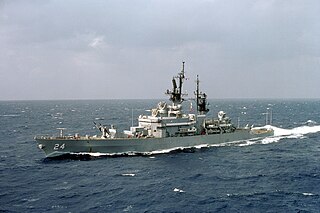
USS Reeves (DLG/CG-24), a United States Navy ship named after Admiral Joseph Mason Reeves, was a Leahy-class cruiser built by the Puget Sound Naval Shipyard, in Bremerton, Washington.

USS Peterson (DD-969), named for Lieutenant Commander Carl Jerrold Peterson (1936–1969), was a Spruance-class destroyer laid down by the Ingalls Shipbuilding Division of Litton Industries at Pascagoula, Mississippi. Peterson was sponsored by Mrs. Miriam C. Peterson, the mother of LCDR Carl J. Peterson. Matron of Honor was Peterson's sister, Mrs. John F. Elliott. She was commissioned on 9 July 1977 and decommissioned on 4 October 2002.

USS Okinawa (LPH–3) was the second Iwo Jima-class amphibious assault ship of the United States Navy. She was the second Navy ship assigned the name "Okinawa", in honor of the World War II Battle of Okinawa.

USS Camden (AOE-2) was the second ship of the United States Navy named after the city of Camden, New Jersey that lies on the Delaware River across from Philadelphia, Pennsylvania. It was a Sacramento-class fast combat support ship, combining the functions of three logistic support ships in one hull - fleet oiler (AO), ammunition ship (AE), and refrigerated stores ship (AF).
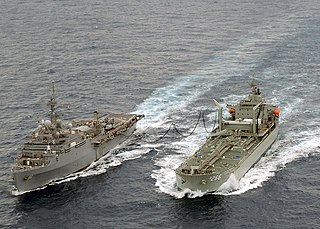
A replenishment oiler or replenishment tanker is a naval auxiliary ship with fuel tanks and dry cargo holds which can supply both fuel and dry stores during underway replenishment (UNREP) at sea. Many countries have used replenishment oilers.

The second USS Seattle (AOE-3), a Sacramento-class fast combat support ship, was laid down on 1 October 1965, at the Puget Sound Naval Shipyard, Bremerton, Washington; launched on 2 March 1968; sponsored by Mrs. William M. Allen, chairman of the board of the Children's Orthopedic Hospital Association, Seattle; and commissioned on 5 April 1969.

USS Detroit (AOE-4) was the fourth and last Sacramento-class fast combat support ship built for the United States Navy. She was laid down on 29 November 1966 by Puget Sound Naval Shipyard, Bremerton, Washington; launched 21 June 1969; and commissioned on 28 March 1970. She is the fifth United States Navy ship named after Detroit, Michigan, the largest city in the state of Michigan, and the river of the same name.

USS Shasta (AE-33) was a Kilauea-class replenishment ammunition ship of the United States Navy. She was named after Mount Shasta, a volcano in the Cascade Range in northern California. Shasta's mission was to support forward deployed aircraft carrier battle groups, which she accomplished through underway replenishment and vertical replenishment. Over three decades, Shasta and her crew took part in the Vietnam War, the Cold War, the Iran–Iraq War, Desert Shield/Operation Desert Storm, and numerous other actions.

USS Fox (DLG-33/CG-33) was a Belknap class cruiser of the United States Navy, named after Gustavus V. Fox, President Abraham Lincoln's Assistant Secretary of the Navy. The keel for DLG-33 was authenticated and laid in ceremonies at Todd Shipyards, Los Angeles Division, San Pedro, California on 15 January 1963.
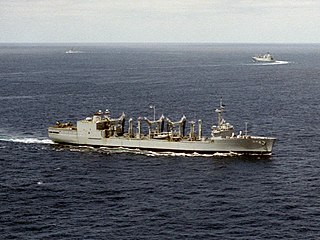
USS Savannah (AOR-4), was a Wichita-class replenishment oiler of the United States Navy. The fifth Savannah was laid down on 22 January 1969 by the General Dynamics Quincy Shipbuilding Division at Quincy, Massachusetts, launched on 23 April 1970, sponsored by Mrs. Ralph L. Shifley, wife of Vice Admiral R. L. Shifley, Deputy Chief of Naval Operations, and commissioned on 5 December 1970.

USS White Plains (AFS-4) was a Mars-class combat stores ship in service with the United States Navy from 1968 to 1995. She was sunk as a target in 2002.

USS Mercury (AK-42) was a cargo ship commissioned by the U.S. Navy for service in World War II. She was responsible for delivering necessary goods and equipment to ships and stations in the war zone.

The Sacramento-class fast combat support ships were a class of four United States Navy supply ships used to refuel, rearm, and restock ships in the United States Navy in both the Atlantic and Pacific Oceans.
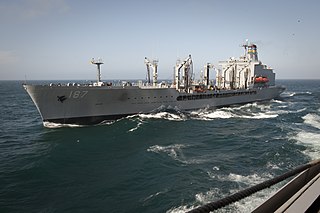
USNS Henry J. Kaiser (T-AO-187) is a United States Navy fleet replenishment oiler and the lead ship of her class. Her mission is to resupply U.S. Navy and allied ships at sea with fuel oil, jet fuel, lubricating oil, potable water, and dry and refrigerated goods, including food and mail.

The Mashū class is a series of replenishment oilers of the Japan Maritime Self-Defense Force. They were built from 2002 to 2004. The ships have the hull designator AOE.
